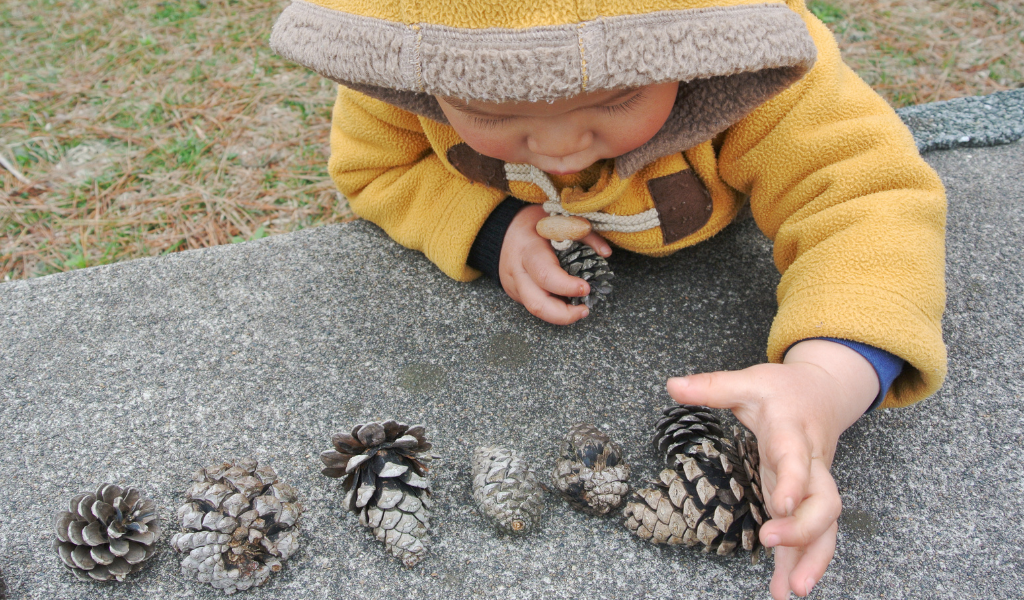In this blog, early years expert Lynnette Brock shares a case study that explores how a greater understanding of schematic play can foster wellbeing, mastery behaviour and learning through free-flow play.
When considering education and care in the early years, we are concerned with supporting the ‘whole’ child: We want to ‘really’ know them; what they think, feel and enjoy. We endeavour to collaborate with their families, furthering our knowledge through positive, collaborative and respectful dialogue, and we appreciate that every child needs to know that they are valued and their behaviours are understood.
Our responses to children’s play and communication matters, and knowledge of schematic play can support children’s mastery, self-belief and a joy of learning.
Jess’s educator was concerned that Jess didn’t really engage with others, but had noticed that she often selected resources that enabled her to construct lines of objects.
Her educator explained, “It is as though something is ‘pulling’ Jess towards these objects; like a light shining on them saying, ‘pick me up and put me in a line’.”

This ‘pull’ is likely to be because Jess feels empowered by this activity and therefore wants to repeat it. She appears to be applying a ‘positioning’ scheme, as identified and categorised by Chris Athey (2007, p174): A sophisticated scheme, that often stems from a child’s earlier trajectory explorations of moving in straight lines.
Sharing this with Jess’s father, he explained that Jess regularly picks up stones from their garden patio and places them on the lawn between two garden fences, adding “She counts them, to twenty-four, I think!”. Jess’s educator thanks her father for this valuable insight: She had not heard Jess counting independently, and reflecting on Jess’s application of a ‘positioning’ and ‘counting’ scheme and her potential investigations, ‘length’, ‘quantity’ or both, she checks whether the groups of objects, already seeded in the provision, effectively support these mathematical enquiries. Other activities were also seeded, promoting the positioning scheme to be applied in a variety of ways, such as puzzles and the story ‘The Very Hungry Caterpillar’, with props.
After observing Jess’s play over the following days, her educator identified that it does appear to be motivated by an early investigation of length: Jess seemed to be checking the lengths of the lines she constructs against her own body.

The next time the educator notices Jess about to dismantle a line of objects, she enquires, “Shall we check how long this is?” Gesturing ‘long’ with her arms. Jess nods and smiles. They construct another line of objects (of blocks, intended to be a non-standard measuring tool). Once the line is complete, they count the blocks until they are level with the end of Jess’s line of stones. As Jess counts the blocks to see how long her line of stones is, her educator draws a tally line on a blackboard. Jess says, “It’s long. There are ten.” The educator checks that she has recorded ten lines by counting them with Jess. Jess laughs, and then scoops up the stones and creates a line of cones (this time measuring 8 in length). Jess continues repeating this activity and records her findings independently.
Jess was eager to show her peers how she could measure and record. She was empowered. The identification of the positioning scheme being explored mathematically in Jess’s self-motivated play, fostered a figurative schema of length and mathematical language, ‘long’, ‘longer’, ‘short’, ‘shorter’. “A word is only as good as the knowing structure, which uses it” (Furth, 1969, p111).
(Piaget, 1969)
We combine schemes every day in everything that we do, whether measuring, reading or even cooking our dinner. In our application of schemes, we also learn about objects. For example, a bucket is a container and we know this because we will have ‘contained’ something inside one.
To enquire about SchemaPlay training, please contact admin@schemaplay.com

Lynnette Brock is the co-founder and director of SchemaPlay Community Interest Company. Over the past seven years, Lynnette has been engaged in two research projects with local authorities in England. This research has led to a personal commitment and a passion to support early years’ educators, childminders and reception class teachers to develop and deepen their knowledge of schematic play.
Athey, C. (2007) Extending Thought in Young Children: A Parent – Teacher Partnership, Sage Publications: London
Furth, H.G (1969) Piaget and Knowledge: Theoretical Foundations, Prentice-Hall: Englewood Cliffs, NJ
Piaget, J. (1969) The Mechanisms of Perception, Routledge & Kegan Paul: London